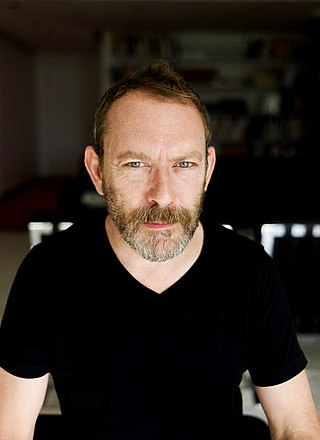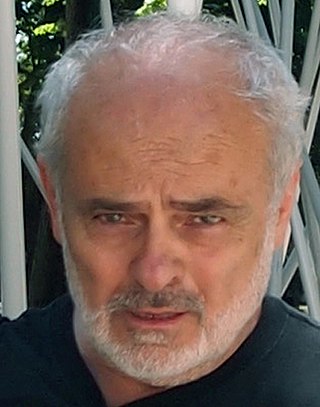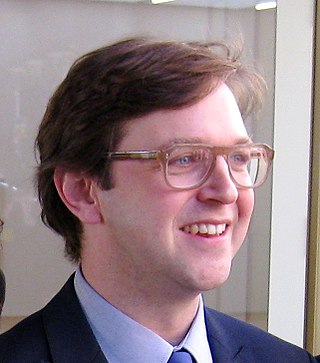Related Research Articles
Carey Young is a visual artist whose work is often inspired by law, politics and economics. The tools, language and architectures of these fields act as material for her videos, text works, performances and photographs, often developing from the professional cultures she explores. In her early video works, she donned attire appropriate to the business and legal worlds, enacting scenarios which examine and question each institution's power to shape society and individual identity. Since 2002, Young developed a large body of work addressing and critiquing law in relation to ideas of site, gender and performance. Young teaches at the Slade School of Fine Art in London where she is an Associate Professor in Fine Art.
Stuart Brisley is a British artist.

David Hall was an English artist, whose pioneering work contributed much to establishing video as an art form.
Dame Sonia Dawn Boyce is a British Afro-Caribbean artist and educator, living and working in London. She is a Professor of Black Art and Design at University of the Arts London. Boyce's research interests explore art as a social practice and the critical and contextual debates that arise from this area of study. Boyce has been closely collaborating with other artists since 1990 with a focus on collaborative work, frequently involving improvisation and unplanned performative actions on the part of her collaborators. Boyce's work involves a variety of media, such as drawing, print, photography, video, and sound. Her art explores "the relationship between sound and memory, the dynamics of space, and incorporating the spectator". To date, Boyce has taught Fine Art studio practice for more than 30 years in several art colleges across the UK.
Jane Wilson and Louise WilsonRA Elect are British artists who work together as a sibling duo. Jane and Louise Wilson's art work is based in video, film and photography. They are YBA artists who were nominated for the Turner Prize in 1999.
Georges Anthony d'Offay is a British art dealer, collector and curator.

Liam Gillick is a British artist who lives and works in New York City. Gillick deploys multiple forms to make visible the aesthetics of the constructed world and examine the ideological control systems that have emerged along with globalization and neoliberalism. He utilizes materials that resemble everyday built environments, transforming them into minimalist abstractions that deliver commentaries on social constructs, while also exploring notions of modernism.
The Artist Placement Group (APG) was conceived by Barbara Steveni in London in 1965, and established in 1966 as an artist-run organisation seeking to refocus art outside the gallery, predominantly through attaching an artist in a business or governmental context for a period of time. Then the participating artists would try to create and organize exhibitions of work related to those new experiences.

Joshua Neustein is a contemporary visual artist who lives and works in New York City. He is known for his Conceptual Art, environmental installations, Land Art, Postminimalist torn paper works, epistemic abstraction, deconstructed canvas works, and large-scale map paintings.
Matthew Higgs is an English artist, curator, writer and publisher. His contribution to UK contemporary art has included the creation of Imprint 93, a series of artists’ editions featuring the work of artists such as Martin Creed and Jeremy Deller. During the 1990s he promoted artists outside the Young British Artists mainstream of the period.
Oliver Payne and Nick Relph are British artist-filmmakers who have collaborated since 1999. Payne was born in 1977, and Relph in 1979. Both studied at Kingston University, London. Payne failed his undergraduate Intermedia course in 2000, and Relph was "booted out" the same year. Curator and critic Matthew Higgs promoted their work and included them in group exhibitions at the Serpentine Gallery (2000) and the Institute of Contemporary Arts (2001) in London. Since then, they have had solo exhibitions in national museums including the National Museum of Contemporary Art, Oslo (2004) and the Serpentine Gallery (2005). According to Artforum, they are "the unanimously hailed first new kids of the post-YBA moment."
EASTinternational is an open submission exhibition that was launched in 1991 and curated by Lynda Morris at Norwich Gallery at Norwich University of the Arts. Applications from over 1,000 contemporary artists are received each year with approximately 25-30 artists selected to exhibit. Many artists who are now recognised as important figures had one of their first major public showings at EAST including Martin Creed, Jeremy Deller, Matthew Higgs, Tomoko Takahashi, Zarina Bhimji, Lucy McKenzie and Runa Islam. Some of these have gone on to win, or be nominated for, the Turner Prize.
Afterall is a nonprofit contemporary art research and publishing organisation. It is based in London, at Central St Martins College of Art & Design. It publishes the journal Afterall; the book series Readers,One Works and Exhibition Histories.

David Thorp is an independent curator and director. He curated GSK Contemporary at the Royal Academy of Arts and Wide Open Spaces at PS1 MoMA New York, among many others. He was Curator of Contemporary Projects at the Henry Moore Foundation and was also director of the South London Gallery, The Showroom and Chisenhale. He has been Associate Director for Artes Mundi, the biannual contemporary art exhibition and prize at the National Museum of Wales, and following the death of Michael Stanley in late September 2012 was appointed Interim Director at Modern Art Oxford. He was a member of the Turner Prize jury in 2004. Since the beginning of 2005 David Thorp has been an independent curator organising and initiating various projects in the UK and abroad. Thorp has held the positions of International Adjunct Curator at PS1 MoMA New York, Associate Curator at Platform China, Beijing, Curator of the Frank Cohen Collection, one of the most important collections of contemporary art in the UK.

Alex Farquharson is a British curator and art critic who was appointed Director, Tate Britain in Summer 2015. As Director, Tate Britain he is Chair of the Turner Prize.
Stuart Comer is an American art curator and writer who is currently Chief Curator of Media and Performance Art at The Museum of Modern Art in New York City. He was co-curator of the 2014 Biennial at the Whitney Museum of American Art, alongside Michelle Grabner and Anthony Elms.
Marc Camille Chaimowicz is a London-based contemporary artist whose works are in the Museum of Modern Art, Tate Modern, and Victoria and Albert Museum collections. His cross-disciplinary work in painting, drawing, collage, sculpture, installation, furniture, lighting, ceramics, textiles, and wallpaper challenges the categorical divisions between art and design.
Lisa Le Feuvre is a curator, writer, editor and public speaker. In 2017 she was appointed the inaugural Executive Director of Holt/Smithson Foundation, an artist endowed foundation that aims to continue the creative and investigative legacies of the artists Nancy Holt and Robert Smithson.
Chrissie Iles is a British-American art curator, critic, and art historian. She is the Anne & Joel Ehrenkranz Curator at the Whitney Museum of American Art in New York City.
Lynda Morris is a British curator who has worked with numerous significant artists including Richard Hamilton and Gilbert and George and given several internationally-renowned artists, such as Agnes Martin, Bernd and Hilla Becher and Gerhard Richter, their first exhibitions in the United Kingdom. Morris has made a significant contribution to the development of contemporary art in the UK through her commitment to supporting emerging artists and through the organisation of EASTinternational, an annual open submission exhibition that took place in Norwich from 1991–2009. Morris is Emeritus Professor of Curation and Art History at Norwich University of the Arts.
References
- 1 2 Hudek, Antony. "A Porous Entity: The Centre for Behavioural Art at Gallery House, 1972-73", in London Art Worlds: Mobile, Contingent, and Ephemeral Networks, 1960–1980. Eds. Jo Applin, Catherine Spencer, Amy Tobin. Pennsylvania State University, 2018. ISBN 978-0271078540. pp. 39-51.
- 1 2 Balsom, Erika (13 March 2017). "LIGHTS, CAMERA, AKTION! Erika Balsom on "Filmaktion: Expanded Cinema and Film Performance"". Artforum. Retrieved 28 July 2020.
- ↑ Curtis, David (2006). A History of Artists' Film and Video in Britain. British Film Institute. p. 39. ISBN 1844570967.
- ↑ Walley, Jonathan (2020). Cinema Expanded: Avant-Garde Film in the Age of Intermedia. Oxford: Oxford University Press. pp. 274–6, 368. ISBN 978-0190938642.
- ↑ Rogers, Holly (2013). Sounding the Gallery: Video and the Rise of Art-Music. Oxford: Oxford University Press. p. 80. ISBN 978-0199861408.
- 1 2 Wood, Gaby (15 March 2018). "This Artist's House Is Not a Home". The New York Times. ISSN 0362-4331 . Retrieved 28 July 2020.
- ↑ Catalogue description material relating to the Sigi Krauss Gallery, Gallery House and the Artists Meeting... 1960–1970s.
- ↑ Comer, Stuart (January–February 2007). "Looking Back: Themed Shows". Frieze: 131.
- ↑ Iles, Chrissie (December 2006). "Best of 2006: Chrissie Iles". Artforum: 272.
- ↑ Tate. "Filmaktion – Exhibition at Tate Modern". Tate. Retrieved 28 July 2020.
- ↑ Biswas, Allie (6 September 2016). "Anthony McCall: 'I wondered if it would be possible to make a film that existed only at the moment of projection'". Studio International. Retrieved 28 July 2020.
- ↑ Forster, Laurel (2010). British Culture and Society in the 1970s: The Lost Decade. Cambridge: Cambridge Scholars Publishing. p. 39. ISBN 978-1443817349.
- ↑ Rozental, Rotem (22 August 2012). "Critics' Picks: Joshua Neustein". Artforum. Retrieved 30 July 2020.